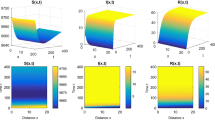Abstract
In this paper, we propose a time-periodic and diffusive SIR epidemic model with constant infection period. By introducing the basic reproduction number \({\mathcal{R}_0}\) via a next generation operator for this model, we show that the disease goes extinction if \({\mathcal{R}_0 < 1}\) ; while the disease is uniformly persistent if \({\mathcal{R}_0 > 1}\).
Similar content being viewed by others
References
Bacaër N., Ait Dads E.: Genealogy with seasonality, the basic reproduction number, and the influenza pandemic. J. Math. Biol. 62, 741–762 (2011)
Bacaër N., Ait Dads E.: On the biological interpretation of a definition for the parameter R 0 in periodic population models. J. Math. Biol. 65, 601–621 (2012)
Bacaër N., Guernaoui S.: The epidemic threshold of vector-borne diseases with seasonality. J. Math. Biol. 53, 421–436 (2006)
Capasso V., Serio G.: A generalization of the Kermack-Mckendrick deterministic epidemic model. Math. Biosci. 42, 41–61 (1978)
Daners D., Koch Medina P.: Abstract Evolution Equations, Periodic Problems and Applications, Pitman Research Notes in Mathematics Series. Vol. 279, Longman, Harlow (1992)
Diekmann O., Heesterbeek J.A.P., Metz J.A.J.: On the definition and the computation of the basic reproduction ratio R 0 in models of infectious disease in heterogeneous populations. J. Math. Biol. 28, 365–382 (1990)
Drnovšek R.: Bounds for the spectral radius of positive operators. Comment. Math. Univ. Carolin. 41, 459–467 (2000)
Friedman A.: Partial Differential Equations of Parabolic Type. Prentice-Hall, Englewood Cliffs (1964)
Hess P.: Periodic-Parabolic Boundary Value Problems and Positivity. Longman Scientific and Technical, Harlow (1991)
Hirsch M.W., Smith H.L., Zhao X.-Q.: Chain transitivity, attractivity and strong repellors for semidynamical systems. J. Dyn. Differ. Equ. 13, 107–131 (2001)
Inaba H.: On a new perspective of the basic reproduction number in heterogeneous environments. J. Math. Biol. 65, 309–348 (2012)
Kato T.: Perturbation Theory for Linear Operators. Springer, Berlin (1976)
Lloyd A.: Realistic distributions of infectious periods in epidemic models: Changing patterns of persistence and dynamics. Theor. Popul. Biol. 60, 59–71 (2001)
Lou Y., Zhao X.-Q.: Threshold dynamics in a time-delayed periodic SIS epidemic model. Discret. Contin. Dyn. Syst. Ser. B 12, 169–186 (2009)
Magal P., Zhao X.-Q.: Global attractors and steady states for uniformly persistent dynamical systems. SIAM J. Math. Anal. 37, 251–275 (2005)
Martin R.H., Smith H.L.: Abstract functional differential equations and reaction-diffusion systems. Trans. Am. Math. Soc. 321, 1–44 (1990)
Metz J.A.J., Diekmann O.: The Dynamics of Physiologically Structured Populations. Springer, New York (1986)
Peng R., Zhao X.-Q.: A reaction-diffusion SIS epidemic model in a time-periodic environment. Nonlinearity 25, 1451–1471 (2012)
Rebelo C., Margheri A., Bacaër N.: Persistence in some periodic epidemic models with infection age or constant periods of infection. Discret. Contin. Dyn. Syst. B 19, 1451–1471 (2014)
Thieme H.R.: Spectral bound and reproduction number for infinite-dimensional population structure and time heterogeneity. SIAM J. Appl. Math. 70, 188–211 (2009)
van den Driessche P., Watmough J.: Reproduction numbers and sub-threshold endemic equilibria for compartmental models of disease transmission. Math. Biosci. 180, 29–48 (2002)
Wang W., Zhao X.-Q.: An epidemic model with population dispersal and infection period. SIAM J. Appl. Math. 66, 1454–1472 (2006)
Wang W., Zhao X.-Q.: Threshold dynamics for compartmental epidemic models in periodic environments. J. Dynam. Differ. Equ. 20, 699–717 (2008)
Zhang L., Wang Z.-C., Zhao X.-Q.: Threshold dynamics of a time periodic reaction-diffusion epidemic model with latent period. J. Differ. Equ. 258, 3011–3036 (2015)
Zhang Y., Zhao X.-Q.: A reaction-diffusion Lyme disease model with seasonality. SIAM. J. Appl. Math. 73, 2077–2099 (2013)
Zhao X.-Q.: Dynamical Systems in Population Biology. Springer, New York (2003)
Zhao X.-Q.: Basic reproduction ratios for periodic compartmental models with time delay, J. Dynam. Diff. Eqns. (2015). doi:10.1007/s10884-015-9425-2
Author information
Authors and Affiliations
Corresponding author
Additional information
Research was partially supported by NSF of China (11371179).
Research was partially supported by the China Scholarship Council and the Fundamental Research Funds for the Central Universities (lzujbky-2015-210).
Rights and permissions
About this article
Cite this article
Zhang, L., Wang, ZC. A time-periodic reaction–diffusion epidemic model with infection period. Z. Angew. Math. Phys. 67, 117 (2016). https://doi.org/10.1007/s00033-016-0711-6
Received:
Revised:
Published:
DOI: https://doi.org/10.1007/s00033-016-0711-6



